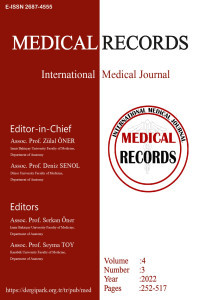Can Neutrophil-Lymphocyte and Platelet-Lymphocyte Ratios Predict the Risk of Developing New Ischemic Lesions After Carotid Stenting?
Can Neutrophil-Lymphocyte and Platelet-Lymphocyte Ratios Predict the Risk of Developing New Ischemic Lesions After Carotid Stenting?
Carotid stenosis, stents, neutrophil, lymphocyte platelet, red cell distribution width.,
___
- Hansson GK. Inflammation, atherosclerosis, and coronary artery disease. N Engl J Med. 2005;352:1685-95.
- Béjot Y, Bailly H, Durier J, Giroud M. Epidemiology of stroke in europe and trends for the 21st century. Presse Médicale. 2016;45:391-8.
- Petty GW, Brown Jr RD, Whisnant JP, et al. Ischemic stroke subtypes: a population-based study of incidence and risk factors. Stroke. 1999;30:2513-6.
- Bonati LH, Kakkos S, Berkefeld J, et al. European Stroke organisation guideline on endarterectomy and stenting for carotid artery stenosis. Eur Stroke J. 2021;6:1-47.
- Barbato JE, Dillavou E, Horowitz MB, et al. A randomized trial of carotid artery stenting with and without cerebral protection. J Vasc Surg. 2008;47:760-5.
- Yabalak A, Yilmaz M. Carotid artery stenting with or without distal filter-type embolic protection device: a single center experience. J Bionic Mem. 2021;1:41-9.
- Lievens D, von Hundelshausen P. Platelets in atherosclerosis. Thromb Haemost. 2011;106:827-38.
- Açar G, Kalkan ME, Avci A, et al. The relation of platelet–lymphocyte ratio and coronary collateral circulation in patients with stable angina pectoris and chronic total occlusion. Clin Appl Thromb. 2015;21:462-8.
- Pereira-Neves A, Fragão-Marques M, Rocha-Neves J, et al. the impact of neutrophil-tolymphocyte ratio and plateletto-lymphocyte ratio in carotid artery disease. Port J Card Thorac Vasc Surg. 2021;28:45-51.
- Deniz M, Ozgun P, Ozdemir E. Relationships between rdw, nlr, car, and apache ii scores in the context of predicting the prognosis and mortality in icu patients. Eur Rev Med Pharmacol Sci. 2022;26:4258-67.
- Chen C, Gu L, Chen L, et al. Neutrophil-to-lymphocyte ratio and platelet-to-lymphocyte ratio as potential predictors of prognosis in acute ischemic stroke. Front Neurol. 2021;11:525621.
- Gökhan S, Ozhasenekler A, Durgun HM, et al. Neutrophil lymphocyte ratios in stroke subtypes and transient ischemic attack. Eur Rev Med Pharmacol Sci. 2013;67:11-3.
- Corriere T, Di Marca S, Cataudella E, et al. Neutrophil-to-lymphocyte ratio is a strong predictor of atherosclerotic carotid plaques in older adults. Nutr Metab Cardiovasc Dis. 2018;28:23-7.
- Varım C, Varım P, Acar BA, et al. Usefulness of the platelet-to-lymphocyte ratio in predicting the severity of carotid artery stenosis in patients undergoing carotid angiography. Kaohsiung J Med Sci. 2016;32:86-90.
- Hyun S, Kwon S, Cho S, et al. Can the neutrophil-to-lymphocyte ratio appropriately predict carotid artery stenosis in patients with ischemic stroke?—a retrospective study. J Stroke Cerebrovasc Dis. 2015;24:2646-51.
- Jiang H, Zhang J, Wu J, et al. Neutrophil-to-lymphocyte ratio correlates with severity of extracranial carotid stenosis—a study using digital subtraction angiography. J Stroke Cerebrovasc Dis. 2017;26:1182-90.
- Deşer SB, Yucel SM, Demirag MK, et al. The association between platelet/lymphocyte ratio, neutrophil/lymphocyte ratio, and carotid artery stenosis and stroke following carotid endarterectomy. Vascular. 2019;27:604-11.
- Keskin M, Öcal L, Cerşit S, et al. The predictive role of a novel risk index in patients undergoing carotid artery stenting: systemic immune-inflammation index. J Stroke Cerebrovasc Dis. 2021;30:105955.
- Dai Z, Li R, Zhao N, et al. Neutrophil to lymphocyte ratio as a predictor of restenosis after angioplasty and stenting for asymptomatic carotid stenosis. Angiology. 2019;70:160-5.
- Bao X, Zhou G, Xu W, et al. Neutrophil-to-lymphocyte ratio and platelet-to-lymphocyte ratio: novel markers for the diagnosis and prognosis in patients with restenosis following cas. Biomark Med. 2020;14:271–82.
- Howard G, Roubin GS, Jansen O, et al. Carotid stenting trialists' collaboration. association between age and risk of stroke or death from carotid endarterectomy and carotid stenting: a meta-analysis of pooled patient data from four randomised trials. Lancet 2016;387:1305-11.
- Furer A, Finkelstein A, Halkin A, et al. High red blood cell distribution width and preclinical carotid atherosclerosis. Biomarkers. 2015;20:376-81.
- Wen Y. High red blood cell distribution width is closely associated with risk of carotid artery atherosclerosis in patients with hypertension. Exp Clin Cardiol. 2010;15:37.
- Feng GH, Li HP, Li QL, et al. Red blood cell distribution width and ischaemic stroke. Stroke Vasc Neurol. 2017;2:172-5.
- Yayın Aralığı: Yılda 3 Sayı
- Başlangıç: 2019
- Yayıncı: Zülal ÖNER
Selim ÇINAROĞLU, Hasan AKKAYA, Hacı KELEŞ, Fatih ÇİÇEK
The Use of Botulinum Toxin in Temporomandibular Disorders: A Bibliometric Study
Serkan YILDIZ, Feridun ABAY, S. Kutalmış BÜYÜK
Ahmet YABALAK, Muhammed Nur ÖĞÜN
Can Cranium Size be Predicted from Orbit Dimensions?
Sema AVCI, Sevinç ŞAHİN, Cemre Nur BALCI
Tuba OZCAN METİN, Gulsen BAYRAK, Selma YAMAN, Adem DOĞANER, Atila YOLDAŞ, Nadire ESER, Duygun ALTINTAŞ AYKAN, Banu YILMAZ, Akif Hakan KURT, Mehmet ŞAHİN, Gulsah GURBUZ
lncRNA MALAT1, MEG3, and PANDAR Levels may be Potential Diagnostic Biomarkers in Multiple Myeloma
Elvin ERÖKSÜZ ÖZDİNÇ, Kuyaş HEKİMLER ÖZTÜRK, Fadime MUTLU İÇDUYGU, Demircan ÖZBALCI
Did the COVID-19 Pandemic Period Increased Suicide Attempts in Society?
Mahmut Zabit KARA, Mehmet Hamdi ÖRÜM, Ayşe Sevgi KARADAĞ, Aysun KALENDEROĞLU
Prediction of Short or Long Length of Stay COVID-19 by Machine Learning
Muhammet ÖZBİLEN, Zübeyir CEBECİ, Aydın KORKMAZ, Yasemin KAYA, Kaan ERBAKAN
